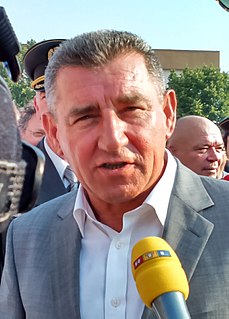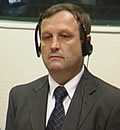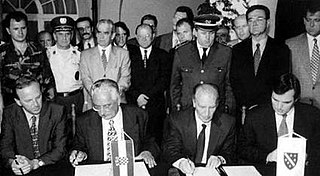Related Research Articles

Operation Storm was the last major battle of the Croatian War of Independence and a major factor in the outcome of the Bosnian War. It was a decisive victory for the Croatian Army (HV), which attacked across a 630-kilometre (390 mi) front against the self-declared proto-state Republic of Serbian Krajina (RSK), and a strategic victory for the Army of the Republic of Bosnia and Herzegovina (ARBiH). The HV was supported by the Croatian special police advancing from the Velebit Mountain, and the ARBiH located in the Bihać pocket, in the Army of the Republic of Serbian Krajina's (ARSK) rear. The battle, launched to restore Croatian control of 10,400 square kilometres of territory, representing 18.4% of the territory it claimed, and Bosnian control of Western Bosnia, was the largest European land battle since the Second World War. Operation Storm commenced at dawn on 4 August 1995 and was declared complete on the evening of 7 August, despite significant mopping-up operations against pockets of resistance lasting until 14 August.

Ante Gotovina is a Croatian retired lieutenant general and former French senior corporal who served in the Croatian War for Independence. He is noted for his primary role in the 1995 Operation Storm. In 2001, the International Criminal Tribunal for the former Yugoslavia (ICTY) indicted him on war crimes and crimes against humanity charges in connection with that operation and its aftermath. After spending four years in hiding, he was captured in the Canary Islands in December 2005.

The Republic of Serbian Krajina or Serb Republic of Krajina, known as the Serbian Krajina or simply Krajina, was a self-proclaimed Serb proto-state, a territory within the newly independent Republic of Croatia, which it defied, and which was active during the Croatian War of Independence (1991–95). It was not recognized internationally. The name Krajina ("Frontier") was adopted from the historical Military Frontier of the Habsburg monarchy and Austria-Hungary, which had a substantial Serb population and existed up to the late 19th century. The RSK government waged a war for ethnic Serb independence from Croatia and unification with FR Yugoslavia and Republika Srpska.

Operation Flash was a brief Croatian Army (HV) offensive conducted against the forces of the self-declared proto-state Republic of Serbian Krajina (RSK) from 1–3 May 1995. The offensive occurred in the later stages of the Croatian War of Independence and was the first major confrontation after ceasefire and economic cooperation agreements were signed between Croatia and the RSK in 1994. The last organised RSK resistance formally ceased on 3 May, with the majority of troops surrendering the next day near Pakrac, although mop-up operations continued for another two weeks.

The Croatian War of Independence was fought from 1991 to 1995 between Croat forces loyal to the Government of Croatia—which had declared independence from the Socialist Federal Republic of Yugoslavia (SFRY)—and the Serb-controlled Yugoslav People's Army (JNA) and local Serb forces, with the JNA ending its combat operations in Croatia by 1992. In Croatia, the war is primarily referred to as the "Homeland War" and also as the "Greater-Serbian Aggression". In Serbian sources, "War in Croatia" and (rarely) "War in Krajina" are used.
The Battle of the Miljevci Plateau was a clash of the Croatian Army and forces of the Republic of Serbian Krajina (RSK), fought on 21–23 June 1992, during the Croatian War of Independence. The battle represented the culmination of a series of skirmishes between the HV and the RSK forces in Northern Dalmatia, after the implementation of the Vance plan and deployment of the United Nations Protection Force (UNPROFOR) began. The skirmishes occurred in the pink zones—areas under control of the RSK, but outside the UN Protected Areas established by the Vance plan.
The Z-4 Plan was a proposed basis for negotiations to end the Croatian War of Independence with a political settlement. It was drafted by Peter W. Galbraith, Leonid Kerestedjiants and Geert-Hinrich Ahrens on behalf of a mini-Contact Group comprising United Nations envoys and diplomats from the United States, Russia and the European Union. The co-chairs of the International Conference on the Former Yugoslavia, David Owen and Thorvald Stoltenberg, were closely involved in the political process surrounding the plan. The document was prepared in the final months of 1994 and early 1995 before being presented to Croatian President Franjo Tuđman and the leaders of the self-declared Republic of Serbian Krajina (RSK) on 30 January 1995. Tuđman was displeased with the proposal, but accepted it as a basis for further negotiations. However, the RSK authorities even refused to receive the document before UNPROFOR mandate status was resolved. According to later reactions, RSK leadership was not satisfied with the plan.

Milan Martić is a Croatian Serb politician who served as the president of the unrecognized Republic of Serbian Krajina between 1994 and 1995, during the Croatian War of Independence.
The Škabrnja massacre was the killing of 62 Croatian civilians and five prisoners of war by Serbian Autonomous Oblast Krajina Territorial Defence troops and the Yugoslav People's Army (JNA) in the villages of Škabrnja and Nadin northeast of Zadar on 18–19 November 1991, during the Croatian War of Independence. The massacre occurred shortly after an agreement to evacuate Zadar's JNA garrison following an increase in fighting between the Croatian National Guard and the JNA. Most of the killings were committed by SAO Krajina troops which followed the leading armoured JNA units fighting their way into Škabrnja on 18 November. During the initial attack, the attacking force employed a human shield of captured civilians forced to walk in front of armoured vehicles. Most of the civilian population fled the village and about 120–130 were captured by the JNA and detained in the village school and kindergarten. However, others who took shelter in basements were killed in or just outside their homes. A portion of those killed in the massacre were buried in a mass grave in Škabrnja, while dozens of bodies were turned over to Croatian authorities.

Operation Summer '95 was a joint military offensive of the Croatian Army (HV) and the Croatian Defence Council (HVO) that took place north-west of the Livanjsko Polje, and around Bosansko Grahovo and Glamoč in western Bosnia and Herzegovina. The operation was carried out between 25 and 29 July 1995, during the Croatian War of Independence and the Bosnian War. The attacking force of 8,500 troops commanded by HV's Lieutenant General Ante Gotovina initially encountered strong resistance from the 5,500-strong Army of Republika Srpska (VRS) 2nd Krajina Corps. The HV/HVO pushed the VRS back, capturing about 1,600 square kilometres of territory and consequently intercepting the Knin—Drvar road—a critical supply route of the self-declared Republic of Serbian Krajina (RSK). The operation failed to achieve its declared primary goal of drawing VRS units away from the besieged city of Bihać, but it placed the HV in position to capture the RSK's capital Knin in Operation Storm days later.
The Saborsko massacre was the killing of 29 Croat residents of the village of Saborsko on 12 November 1991, following the seizure of the village in a Yugoslav People's Army and Croatian Serb offensive during the Croatian War of Independence. The fall of the town occurred as part of a JNA and Croatian Serb operation to capture a Croatian-held pocket centered on the town of Slunj, southeast of Karlovac. While the bulk of the civilian population fled with the surviving Croatian forces, those who remained in Saborsko were rounded up and either killed or expelled. The bodies of the victims were retrieved from two mass graves and several individual graves in 1995.
Mladen Markač is a Croatian retired general. He was a Commander of Croatian Special Police during Operation Storm during the Croatian War of Independence (1991–1995), and afterwards held the rank of Colonel General. Later, he was indicted by the International Criminal Tribunal for the Former Yugoslavia (ICTY) for war crimes committed during Operation Storm by Croatian forces against the Serbs from Croatia. In April 2011, the ICTY found him guilty and sentenced him to 18 years.
The Varivode massacre was a mass killing that occurred on 28 September 1995 in the village of Varivode, Croatia during the Croatian War of Independence. According to United Nations officials, soldiers of the Croatian Army (HV) and Croatian police killed nine Serb villagers, all of whom were between the ages of 60 and 85. After the war, six former Croatian soldiers were tried for committing crimes in the village, but were all eventually released due to lack of evidence. In 2012, the Supreme Court of Croatia ruled that the Republic of Croatia was responsible for the killings, dubbing the massacre an "act of terrorism," and the following year the municipal court in Knin announced that the Government of Croatia must provide compensation to the children of a couple who were murdered.
The Trial of Gotovina et al. was a war crimes trial held from March 2008 until November 2012 before the International Criminal Tribunal for the former Yugoslavia (ICTY), set up in 1993. The ICTY indicted Croatian Army (HV) generals Ante Gotovina, Ivan Čermak and Mladen Markač for war crimes, specifically for their roles in Operation Storm, citing their participation in a joint criminal enterprise (JCE) aimed at the permanent removal of Serbs from the Republic of Serbian Krajina (RSK) held part of Croatia.

The Split Agreement or Split Declaration was a mutual defence agreement between Croatia, the Republic of Bosnia and Herzegovina and the Federation of Bosnia and Herzegovina, signed in Split, Croatia on 22 July 1995. It called on the Croatian Army (HV) to intervene militarily in Bosnia and Herzegovina, primarily in relieving the siege of Bihać.
The Golubić killings was the mass murder of at least 18 Serb civilians from the village of Golubić in the county of Šibenik-Knin County on 6 August 1995, by members of the Croatian Army (HV) during Operation Storm.
The Gošić kllings refers to the mass murder of elderly Serb civilians from the village of Gošić in Šibenik-Knin County by members of the Croatian Army (HV) on 27 August 1995, approximately three weeks after Operation Storm.
The Komić killings refers to the mass murder of elderly Serb civilians from the village of Komić in August 1995 by members of the Croatian Army (HV), five days after Operation Storm.
The Kijani killings refers to the mass murder of elderly Serb civilians from the village of Kijani near the town of Gračac by members of the Croatian Army (HV) during and following Operation Storm.
The Grubori massacre was the mass murder of six Serb civilians from the village of Grubori, near Knin, on 25 August 1995 by members of the Croatian Army (HV) in the aftermath of Operation Storm. The massacre was listed in the ICTY's indictment of Croatian wartime generals Ante Gotovina, Ivan Čermak and Mladen Markač.
References
- 1 2 3 4 Milekic, Sven (4 August 2017). "Croatia's Operation Storm: Crimes Unpunished 22 Years On". BalkanInsight. BIRN.
- ↑ Lucien, Ellington (2005). Eastern Europe: An Introduction to the People, Lands, and Culture, Volume 1. ABC-CLIO. p. 437. ISBN 978-1-57607-800-6.
- ↑ Chuck Sudetic (20 May 1991). "Croatia Votes for Sovereignty and Confederation". The New York Times.
- ↑ Raič, David (2002). Statehood and the Law of Self-Determination. Martinus Nijhoff Publishers. p. 350. ISBN 978-9-04111-890-5.
- ↑ Sudetic, Chuck (2 April 1991). "Rebel Serbs Complicate Rift on Yugoslav Unity". The New York Times.
- ↑ Bartrop, Paul R. (2012). A Biographical Encyclopedia of Contemporary Genocide: Portraits of Evil and Good. ABC-CLIO. p. 28. ISBN 978-0-31338-679-4.
- ↑ "Milosevic: Important New Charges on Croatia". Human Rights Watch. 21 October 2001. Archived from the original on 25 December 2010.
- ↑ Bassiouni, Mahmoud Cherif; Manikas, Peter (1996). The Law of the International Criminal Tribunal for the Former Yugoslavia. Transnational Publishers. p. 86. ISBN 978-1-57105-004-5.
- ↑ Blank, Laurie R.; Noone, Gregory P. (2018). International Law and Armed Conflict: Fundamental Principles and Contemporary Challenges in the Law of War. Wolters Kluwer Law & Business. p. 517. ISBN 978-1-54380-122-4.
- ↑ Clark, Janine Natalya (2014). International Trials and Reconciliation: Assessing the Impact of the International Criminal Tribunal for the Former Yugoslavia. Routledge. p. 37. ISBN 978-1-31797-474-1.
- ↑ Razsa, Maple (2015). Bastards of Utopia: Living Radical Politics after Socialism. Indiana University Press. pp. 239–240. ISBN 978-0-25301-588-4.
- 1 2 3 Bajto, Nikola; Opačić, Tamara; Jovanović, Nenad (15 October 2018). "Dossier: Zločini nad Srbima". Novosti.
- ↑ "Gotovina - Indictment". ICTY.org. International Criminal Tribunal for the former Yugoslavia. 21 May 2001.
- 1 2 "Gotovina and Markac, IT-06-90-A" (PDF). ICTY.org. International Criminal Tribunal for the former Yugoslavia. 16 November 2012. pp. 30–34.